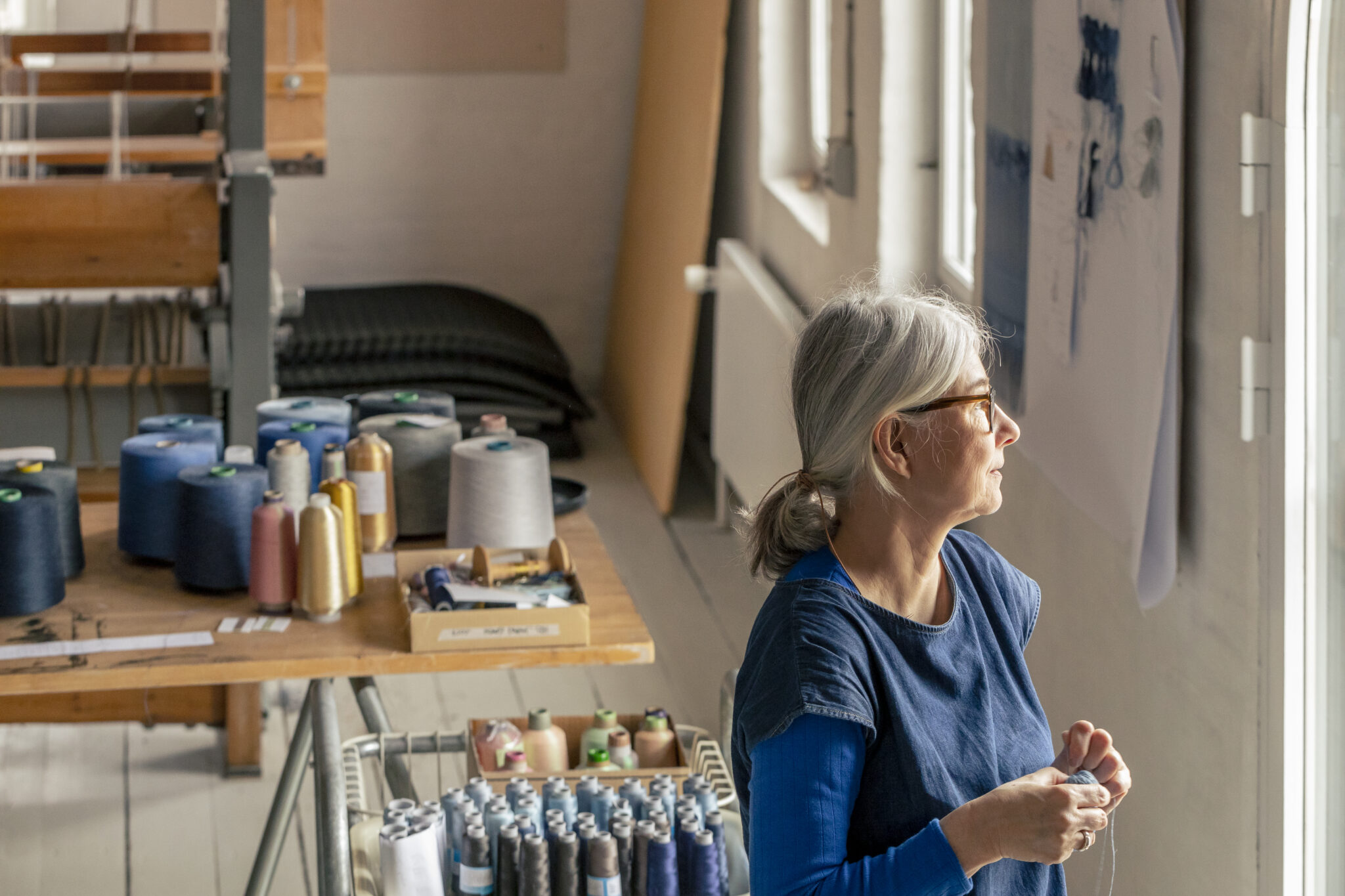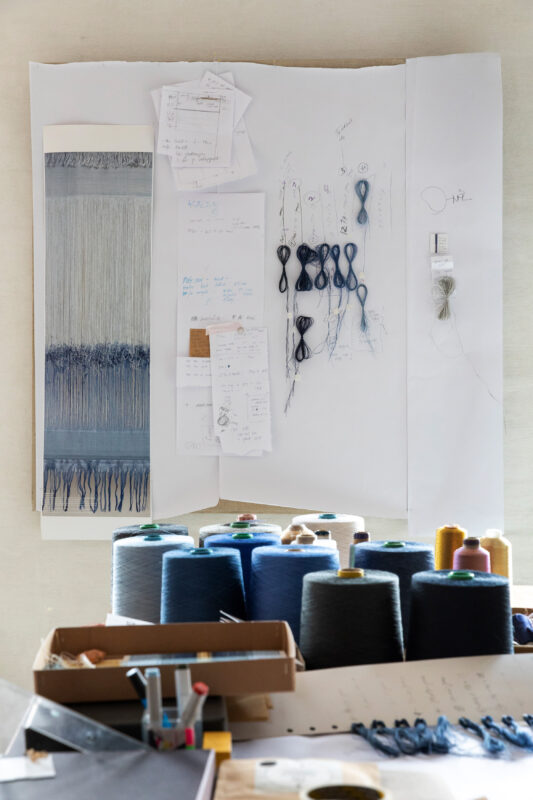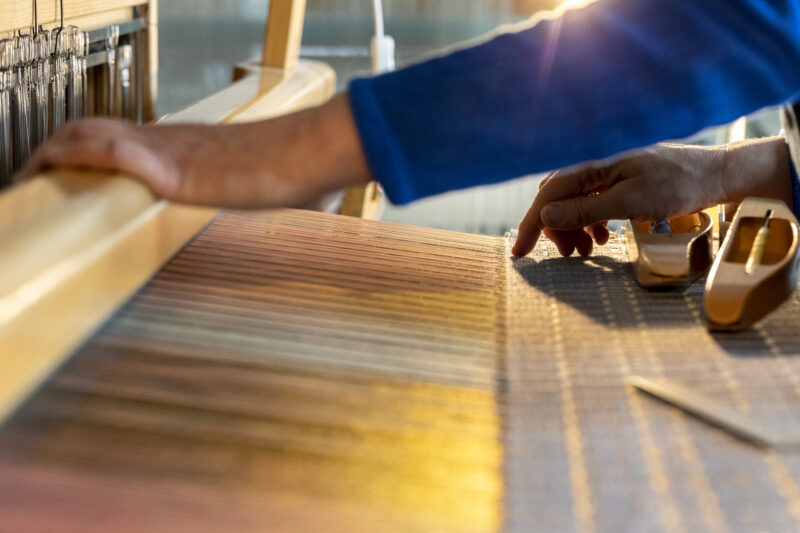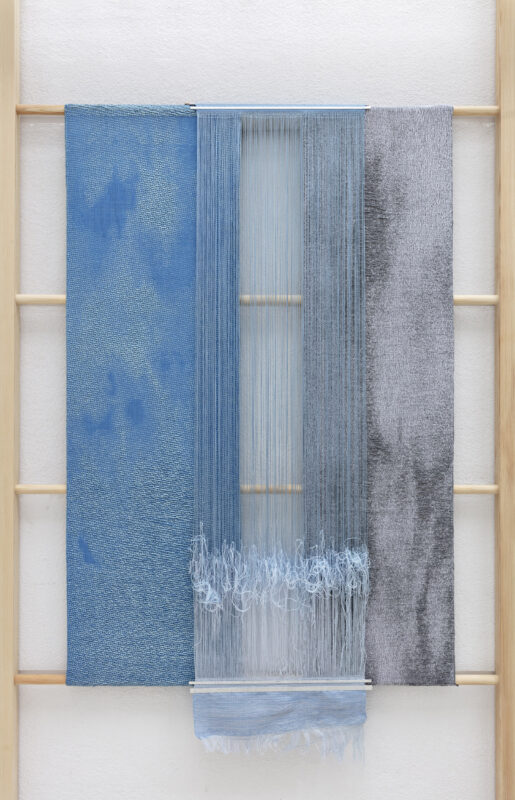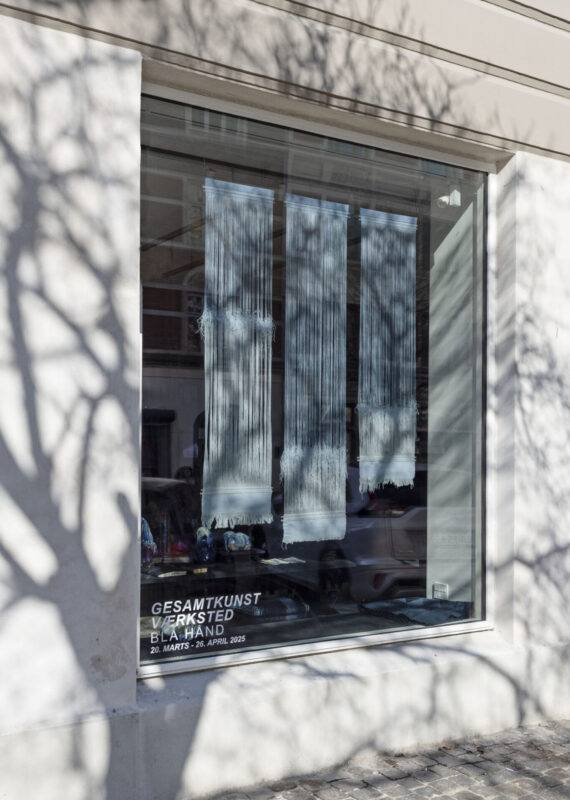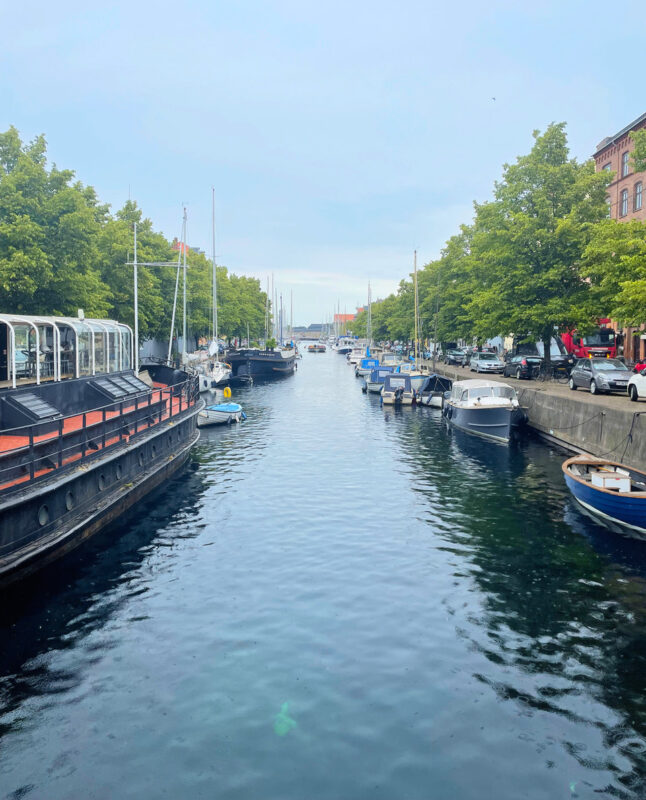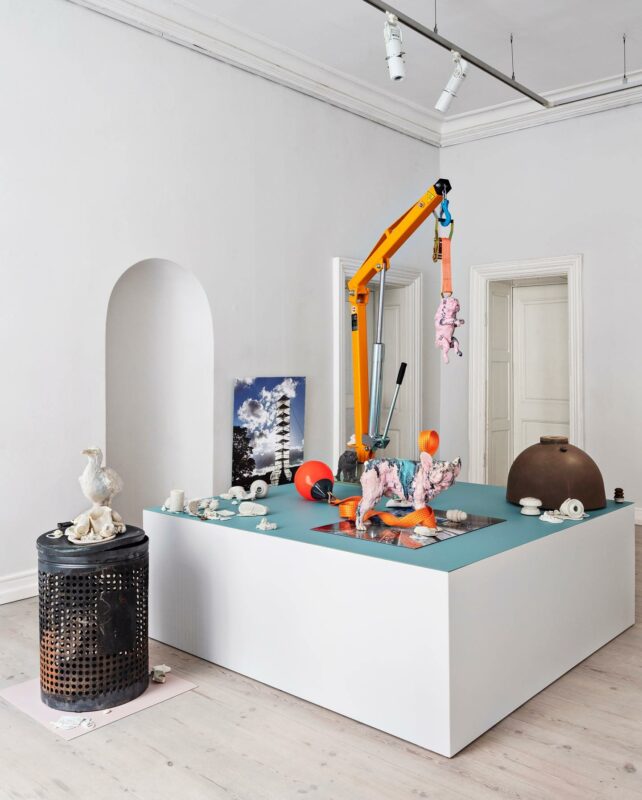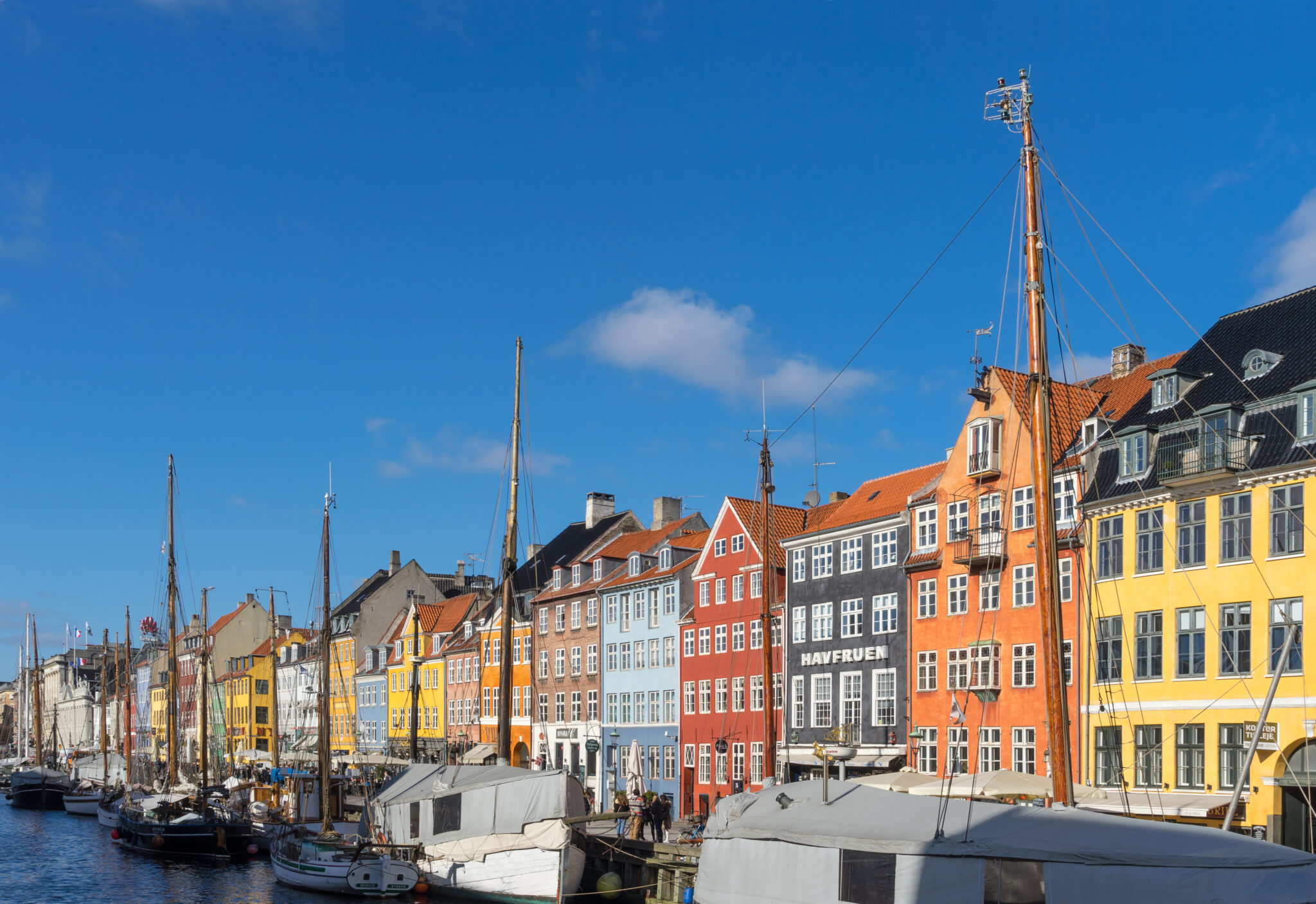Helle Trolle’s textiles are born out of her fascination with structures, materials and the subtleties of everyday life. Her work deals with the simple yet profound—how the sky turns blue, how rain feels on the skin, how temperature can be translated into colour—and transforms these observations into woven forms that are playful, multi-layered and multidimensional. Using both analogue and digital looms, she explores the possibilities of different materials to create contemporary textiles that tell their own story.
For Trolle, weaving is both a craft and a language. Guided by self-imposed rules, curiosity and a love of experimentation, she designs each piece individually—whether it’s a three-dimensional form, a warm blanket or a textile work of art. She has recently begun dyeing her own fibres through botanical experiments, adding new textures and colours. Through her own workshops, Trolle passes on her knowledge and makes it accessible to others.
© Kirstine Autzen
Which place do you currently call home and where do you work on your projects?
I live in Frederiksberg, a district of Copenhagen. It is a self-governing district and municipality in the Greater Copenhagen area, surrounded by the municipality of Copenhagen. It is also the most densely populated municipality in Denmark and has high green ambitions, which are reflected in a multitude of beautiful trees, parks, gardens and street cafés.
While working on large projects and special research initiatives in the city, I am fortunate to spend time in the weaving workshop of the National Art Workshops in the Christianshavn district – a beautiful part of the city right by the sea.
Where is your studio located & how does it look?
My studio is located at Nørre Søgade 15 D, in the Nansensgade area of Copenhagen.
When the city gets too crowded, I retreat to my workshop on the small island of SAMSØ — three hours away by train and ferry. Staying there and working for long periods of time is always a real treat, far from the noise of the city.
© Helle Trolle
© Kirstine Autzen
© Kirstine Autzen
Are there any projects that are personally important to you—whether recently completed or currently in progress?
I am working on a serie called CLOUDS—transformation of the sky. These images were part of my recent show at Til:værks.
© Dorte Krogh
© Dorte Krogh
© Laura Stamer
Do you have a favorite place in your area where you like to relax and linger?
Staying in my local area, I simply cross the road to take a walk in the large park, Frederiksberg Have, or in the smaller park, Haveselskabets Have. This garden is a peaceful place, divided into many smaller ‘rooms,’ each with its own character.
On spring and summer days, I often visit a friend who has a workshop near Copenhagen Cable Park. I’ve never tried the board sports there, but the relaxed beach atmosphere, the cozy café, and the view across the blue sea all the way to Sweden make it a wonderful place to spend time.
I enjoy jumping on my bike and riding along the Green Cycle Path. It’s a route through the city that leads me to places I never knew existed—like experiencing the city behind the façade.
© Ikiwaner, Frederiksberg Slot, adjusted colours, CC BY-SA 3.0
Are there any urgent political issues or problems in your region?
Like everyone else right now, I worry about the wars in Europe and about the climate change.
Do you know a hidden gem when it comes to local manufacturers—whether it’s arts and crafts, sustainable products or food?
When I’m looking for local handicraft makers, special tapas and wines, or antiques, I head to the end of Vesterbrogade, close to my home. Starting at Designers Zoo (no. 137) and walking all the way down the street, you’ll find a collection of unique shops: jewellery from Wang & Buck, handmade leather goods, origami lamps from Sonobelight, a furniture workshop, posters, letterpress prints, ceramics, antiques, and Enomania wine.
Is there anything particularly innovative in your region? Also in comparison to other places you have already visited?
I find Culture houses with workshops very special for the Copenhagen area. The Library at Rentemestervej in Nordvest, a district in Copenhagen, welcomes school kids and the public alike. It hosts interesting exhibitions, workshops, and a wide range of courses in textiles, graphic printing, sewing, and more. People of all ages and nationalities use these excellent facilities. There is room for everyone—both professionals and amateurs—working side by side and inspiring each other. If you get hungry during your visit, there’s a very nice café called FLOK. You can also visit the café Flere Fugle in the backyard of Demokrati Garage.
While you’re in the area, be sure to visit the magnificent Grundtvig Church and the unique apartments on Bispebjerg Bakke, designed by the artist Bjørn Nørgaard. End your trip at Bispebjerg’s Healing Gardens, located near the old hospital.
My favourite exhibition space is Copenhagen Contemporary (CC), located in the fascinating area of Refshaleøen. Once a separate island and a former industrial site in Copenhagen’s harbour, this district is now connected to the city by bridges and ferry. Its raw surroundings, waterside views, and vibrant street food scene make it a unique destination for art lovers and visitors alike.
If you’re visiting from the heart of Copenhagen, I suggest taking the ferry bus line 993. It stops at Operaen Holmen, right next to the Royal Danish Academy—where I teach. The space often hosts exhibitions that are open to the public, and they are always worth a visit.
From there, you can take a peaceful walk through Holmen, the city’s old naval district, and continue all the way to Copenhagen Contemporary.
It’s a journey I never get tired of—a beautiful blend of water, history, and creativity.
© Alice Meozzi
© Farzad Soleimani
Do you have a secret restaurant tip that you would like to share with us?
I sometimes go for brunch at Hotel Ottilia in the new part of town, Carlsbergbyen, to enjoy the hotel vibe.
For lunch, I would go to Fasangården in Frederiksberg Have. It’s a newly renovated pheasant hunter’s house with a tactile and colorful interior, featuring woven fabrics from Kjellerup Væveri.
In the evening, I’d go to Juniors for a very nice and authentic Italian meal. If it gets really late, I might end up in Allégade—an old party street in Frederiksberg—where you could have a great time at the legendary Café Intime.
Is there a local shop whose products are only available in your region?
Danish Crafts & Design Association (DKoD) is a national organization for professional designers and makers. Here, you’ll find many contemporary creators who continue to build on tradition with new expressions, formats, techniques, and materials. You can get in touch with these skilled craftspeople through the DKoD homepage, and many of them offer workshops or are part of collective shops.
© DKoD
© DKoD
What are your 3 favourite apps that you use every day and couldn’t live without?
Instagram suits me perfectly—I can easily post and share my works and projects, I see relevant content and get connected to many interesting and like minded textile people.
I use 2 news apps: I read the Danish television news on the DR app and listen to Zetland, a digital platform dedicated to journalism driven by insight and curiosity. As they say, “We reject the present-day cynicism and polarization that paint the world in black and white and undermine our ability to overcome important challenges together.”
Third Ear is my favorite podcast producer—I listen whenever they release a new story!
Do you have any favourite newspapers or online magazines? And how do you keep up to date with politics or social and cultural issues?
During weekends I receive the newspaper Politiken.
Twice a year, I get the bookazine Håndværk, also available in English. In these publications, writer and photografer Rigetta Klint focuses on craft both in its own right and as a foundation for architecture, art, fashion, interior design, and even a good meal.
I read Art Matter every week to keep up with art and exhibitions.
Whenever possible, I follow the World Hope Forum, founded by Lidewij Edelkoort and Philip Fimmano. It’s a great opportunity to explore and expand knowledge globally, while gaining insights into innovation, sustainability, new perspectives on craft, and hope.
© Jebulon, Nyhavn facades Copenhagen Denmark, CC0 1.0
Imagine you could be mayor for a year—what would you change?
I would make public transportation free for everyone and help children experience the joy of losing themselves for a while while working on creative projects and processes.
One last question: If you could choose another place to live—regardless of financial or time constrains—which one would you choose?
In beautiful Japan—on the island of Shikoku, with all its temples, hardworking indigo dyers, and craft workshops, especially BUOISOU Indigo. Shikoku is located close to the art islands Teshima and Naoshima and just a train ride from Kyoto.

